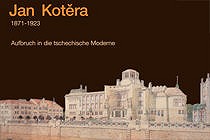
|
Jan Kotera 1871-1923 The Founder of Modern Czech Architecture Press Conference: Wednesday, April 23, 2003, 11:00 AM Opening: Wednesday, April 23, 2003, 7:00 PM Exhibition: April 24 - July 7, 2003 Openning Hours:Daily 10:00 am - 07:00 pm, Wednesday 10:00 am - 09:00 pm Press Relesase Jan Kotera (1871-1923) is one of the key figures of modern European architecture, and this exhibition pays tribute to his architectural oeuvre in the first comprehensive show to have been held outside the Czech Republic. The Architekturzentrum Wien welcomes the launch of a dialogue between Vienna and Prague that elucidates a shared piece of 20th century European history with a show of knowledge, ideas and designs that could have potential for the future. Along with Josef Hoffmann, Josef Maria Olbrich and Joze Plecnik, Jan Jan Kotera was one of the first students to complete Otto Wagner"s special course at the Academy of Fine Arts in Vienna. Jan Kotera returned to Prague after his studies at the Vienna Academy, where he immediately adopted a significant role in artistic and social life. As a professor – initially at the arts and crafts college (Kunstgewerbeschule, 1898-1910) and later at the Prague Academy of Fine Arts (1910-1923) – Jan Kotera began to exert a decisive influence on the next generation of architects. Among his students were Josef Gocar, Otakar Novotny, Kamil Roskot, Bohuslav Fuchs, Jaromir Krejcar Jan Kotera – his oeuvre Haus Peterka (1899-1900) on Wenceslas Square is the first building that Kotera completed in Prague following his return from Vienna. Together with the Hotel Central by Friedrich Ohmann (1899-1901), Haus Peterka was the first Jugendstil building in Prague. With his thinking and his work, Jan Kotera increasingly strove against the flamboyant decoration of the eclectic historicist style that was dominant at the end of the 19th century. He was very early to leave the methods and stylistic means of Jugedstil behind him, and in his own work he soon arrived at a form of architecture that is characterised by a reduction of facade decoration in favour of the transparency of the construction and the materials used. "So purpose, construction and place are the driving forces – the form is a consequence of these." Jan Kotera 1908 was a key year in the architectural oeuvre of Jan Kotera. Two buildings in Prague mark the highpoint of this phase of upheaval: his own villa and the house for the publisher Jan Laichter, which are significant for their precision of tectonic expression. Shortly afterwards, Béla Lajta in Budapest and a number of Otto Wagner"s students in Vienna, such as Joze Plecnik, arrived at a similarly clear architectural language. Kotera"s long-held wish to be able to complete at least one monumental building in Prague was never fulfilled. Another building outside the capital became the early highpoint of his oeuvre: the municipal museum of history and crafts in Hradec Kralove (1909–1913). The museum reflects the atmosphere of cultural change that dominated the Czech province in its demanding design, competing with the cosmopolitan city of Prague on a cultural and artistic level. Kotera"s later buildings, which include the Karlsuniveristät (1918-1921), all issue from a classicist stance. The exhibition As well as the scope of his effectiveness as a teacher, Kotera left us with an exceptional architectural oeuvre, as can be seen in Villa Lemberger-Gombrich (Vienna, 1913-1915). The complete work of this pioneer of modern architecture in the Czech Republic, from projects completed during his student days at Otto Wagner"s special architecture course, via the highpoint of his accomplishments to his late-work, is being shown in the exhibition at the Architekturzentrum Wien in the form of original drawings, sketches, photographs and models. The exhibition was elaborated by the Obecni dum, Prague, and has been on view at previous venues in Prague and Hradec Kralove. The Publication A book has been published to accompany the exhibition entitled `Jan Kotera 1871-1923. The Founder of Modern Czech Architecture´. Available in English and Czech from the Az W. Published by Obecni dum, Prague, and KANT publishing house, 416 pages / 400 illustrations, Euro 55 Thursday, April 24, 2003 / 7pm "Czech Architecture Now" panel discussion (in English) The architectural achievements of the Czech Modernists of the 1920s and 30s are irrefutable today. Less well known is that contemporary production links up directly with the international standards of its predecessors. Moderated by Irena Fialova Roman Koucky, Architect, Prague: the margins and the city – on architecture inside cities Petr Dvorak, A.D.N.S. Architects, Prague: "designing architecture - executing architecture" / on working with foreign architects / Ladislav Kuba, Tomas Pilar, Architects, Brno: "architectural competitions, yes or no" / on competitions and realizations The exhibition Jan Kotera 1871-1923. The Founder of Modern Czech Architecture has been organised in collaboration with the Obecni dum and the Narodni Technicke Muzeum of Prague. Concept: Vladimir Slapeta Scientific co-operation: Petr Krajci, Radmila Kreuzziegerova, Rostislav Svacha Project management: Radmila Kreuzziegerova, Vanda Skalova Curator, Az W: Monika Platzer Sponsors of the exhibition: ERSTE BANK, Immorent AG Sponsors of the Az W: Geschäftsgruppe Stadtentwicklung und Verkehr; Bundeskanzleramt Sektion Kunst; Wien Kultur; Bundesministerium für Bildung, Wissenschaft und Kultur; UNIQA Versicherungen AG, Zumtobel Staff Österreich Vertriebs-GmbH |
 |
|
© Az W |
|
Press page Current events Past events Gallery: Press images Dates: Jan Kotera 1871 - 1923 Information: Ines Purtauf Tel.: +43 (1) 522 31 15 - 25 Fax: +43 (1) 522 31 17 Email: purtauf@azw.at |
| © Architekturzentrum Wien 2025 |
||



